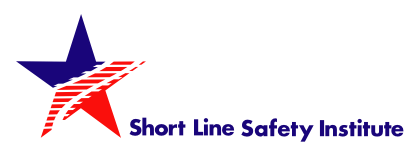Ten Core Elements of a
Strong Safety Culture
The Short Line Safety Institute has adopted the U.S. Department of Transportation Safety Council’s definition of safety culture, as well as the Ten Core Elements of
a Strong Safety Culture. Safety culture is defined as “The shared values, actions, and behaviors that demonstrate a commitment to safety over competing goals and demands.” The Ten Core Elements of a Strong Safety Culture are listed below.
1. Leadership Is Clearly Committed to Safety
The importance of leadership in fostering a strong safety culture was clearly indicated by the fact that almost all of the safety culture models explicitly included some mention of leadership commitment to safety. Leaders across all layers of a railroad must model safety-first attitudes and behaviors. Employees learn what the accepted practices are in a railroad by following the examples set by its leaders.
2. The Railroad Practices Continuous Learning
Maintaining a strong safety culture necessitates a learning environment where opportunities to improve safety are continuously sought out and implemented. Railroads must be open to learning from accidents when they do happen and willing to make changes to prevent incidents in the future.
3. Decisions Demonstrate that Safety Is Prioritized Over Competing Demands
One of the most unique elements of an organization with a strong safety culture is that their decision-making processes clearly demonstrate that safety is prioritized over competing demands. Railroads with a strong safety culture will consistently choose safety over performance when faced with the choice of cutting corners to increase performance.
4. Reporting Systems and Accountability Are Clearly Defined
Organizations must ensure that reporting systems and lines of accountability are in place so that safety issues can be promptly identified, fully evaluated, and promptly addressed and corrected commensurate with their significance.
5. There Is a Safety Conscious Work Environment
Maintaining a strong safety culture also requires constant vigilance and an elevated awareness of the importance of safety. Employees should be encouraged to raise safety concerns and provided opportunities to raise concerns through reporting systems and procedures.
6. Employees Feel Personally Responsible for Safety
Employees who feel personally responsible for safety take more ownership in following safety procedures and are also more likely to speak up when they see other employees behaving in an unsafe manner. Personal responsibility empowers employees and helps the entire organization identify and correct risks proactively.
7. There Is Open and Effective Communication Across the Railroad
Employees must feel comfortable communicating to their supervisors about safety issues and communicating with their peers when they see unsafe behaviors. If the railroad is not communicating the importance of safety and encouraging their employees to speak up about safety,then safety risks are more likely to develop and less likely to be addressed before an accident occurs.
8. Mutual Trust Is Fostered Between Employees and the Railroad
One of the cornerstones of any positive organizational culture is trust. Trust among all railroad employees, from craft employees to senior leaders, can go a long way to support safety by facilitating open and honest communication and minimizing fears of reprisal. Employees who have developed a relationship of trust with their supervisors may feel more willing to raise safety concerns in novel situations when they are unsure of how the railroad might respond.
9. The Railroad Is Fair and Consistent in Responding to Safety Concerns
Above and beyond having effective reporting procedures and processes in place, the railroad must respond to safety concerns in a manner that employees perceive as fair, just, and consistent. Employees should feel free to raise safety concerns without fear of retaliation.
10. Training and Resources Are Available to Support Safety
Those who manage and operate the system must have current knowledge about the human,technical, organizational, and environmental factors that determine the safety of the system as a whole, and have the tools and equipment available to perform their job duties in the safest manner possible. In addition, the organization must ensure that the personnel, procedures, and other resources needed to ensure safety are available. Understaffing safety-critical positions or not having formal, written procedures for ensuring safety can be just as detrimental as a lack of physical equipment.
Source: Research Paper Prepared for the US DOT Safety Council, May 2011

